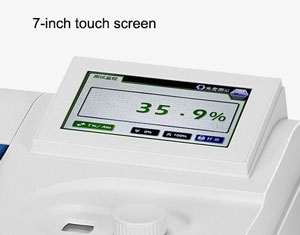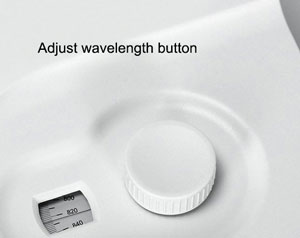VIS spectrophotometer with backlight LCD display, easy to read, single beam, accurate automatic T/A conversion, automatic adjustment of 0A and 100% T, widely used in medical testing, food, petrochemical, environmental protection, monitoring and other industries.

7-inch touch screen
- Adopt 7-inch color touch LCD display, flexible and convenient operation.
- Streamlined shape and compact size.
- Built-in thermal printer.
- Multi-purpose analyzer.

Adjusting wavelength knob
- Manually adjust the wavelength for testing.
- Adopt microprocessor control technology.
- Qualitative and quantitative analysis of substances in the visible spectrum.
Application
The spectrophotometer is easy to operate, has perfect functions and high reliability, and can be widely used in drug testing, drug analysis, environmental testing, hygiene, and food epidemic prevention.
| Models | SISCO-721G | SISCO-722G |
| Optical System | Single beam, diffraction grating | |
| Wavelength Range | 340-1000 nm | 325-1000 nm |
| Light Source | Tungsten halogen lamp 12V/20W | |
| Receiving Component | Photocell | |
| Wavelength Accuracy | ±2nm | |
| Wavelength Repeatability | ≤1nm | |
| Spectrum Bandwidth | 5nm | |
| Transmittance Accuracy | ±0.5% (T) (NBS930D) | |
| Transmittance Repeatability | ≤0.2% (T) | |
| Transmittance Measuring Range (T) | 0.0%~100.0% | |
| Absorbance Measuring Range (A) | 0.000~1.999 | |
| Concentration Read-out Range | 0000~1999 | |
| Stray Light | ≤0.5% (T) (at 360nm, NaNO2) | |
| Drifting | ≤0.5% (T)/3min | |
| Signal Noise (T) | 100% Noise≤0.3%, 0% Noise≤0.2% | |
| Port | RS232 | |
| Cell Holder | 50mm | |
| Power Supply | 220V 50Hz (Optional 110V 60Hz: pls tell us by email) | |
| G.W. | 13.5kg | |
| Package Dimensions | 560 x 480 x 290mm | |
| Software | Optional | |
A1: What is the difference between a UV-Visible spectrophotometer and a visible spectrophotometer?
Q1: The difference between UV-Visible spectrophotometer and visible spectrophotometer is that the measurement wavelength range is different, UV generally uses a hydrogen lamp, measurement wavelength range is of 180 ~ 350NM, visible generally uses a tungsten lamp, and the measurement wavelength range of 320 ~ 1000NM. The so-called UV-Visible spectrophotometer also means that this instrument can change the light source, can determine the absorption peak in the UV and visible part of the compound.
A2: What is the wavelength range of the UV-Visible spectrophotometer?
Q2: Ultraviolet-visible (UV-Vis) spectrophotometers use a light source that illuminates the sample with light in the UV to visible wavelength range (typically 190 to 900 nm). UV-Vis-NIR spectrophotometers extend the wavelength range to the near-infrared (NIR) (800 to 3200 nm).
A3: What is the principle of operation of a spectrophotometer?
Q3: The basic principle of the spectrophotometer is that the substances in solution are excited by light irradiation, resulting in the effect of light absorption, the absorption of light by substances is selective, a variety of different substances have their own absorption spectrum, so when a monochromatic light through the solution, its energy will be absorbed and diminished, the degree of light energy diminution and the concentration of substances have a certain proportional relationship, that is, in line with the colorimetric principle - -Biel's law.
Tips: How to maintain the spectrophotometer?
A spectrophotometer is a precision instrument. Due to the working environment, operating methods, and other reasons, its technical conditions will inevitably change during operation, thus affecting the performance of the instrument and even causing equipment failure. Therefore, analysts are able to detect and eliminate these hidden dangers in time to ensure the normal operation of the instrument and equipment.
- If a significant change in test wavelength occurs, wait a few moments until the lamp reaches thermal equilibrium, recalibrate the "0" and "100%" points, and then re-measure.
- Immediately after use, rinse the colorimeter with distilled water and wipe off the watermark with a clean soft gauze to avoid surface damage that may affect the light transmission of the colorimeter.
- The operator had better not move the bulb and the reflector lamp to avoid affecting the light effect.
- The sensitivity of the amplifier must be re-zeroed after a change.
- The cuvette should be assorted. The cuvette must be compatible for use; otherwise, it will make the test results meaningless.
Thank you for buying industrial test and measurement equipment on SISCO.com, all products sold by SISCO and the partner cover a 12 months warranty, effective from the date of receiving the products.
What is covered?
SISCO is responsible for providing free spare parts, and free technical support to assist the customer to repair the defective products until the problem is solved.
What is not covered?
- Product purchased from anyone other than a SISCO store or a SISCO authorized reseller.
- Expendable parts.
- Routine cleaning or normal cosmetic and mechanical wear.
- Damage from misuse, abuse or neglect.
- Damage from use of parts other than SISCO approved.
- Damage from use outside the product’s usage or storage parameters.
- Damage from use of parts not sold by SISCO.
- Damage from modification or incorporation into other products.
- Damage from repair or replacement of warranted parts by a service provider other than a SISCO authorized service provider.
- Damage caused by the application environment not meeting the product usage requirements and the failure to perform preventive maintenance.

